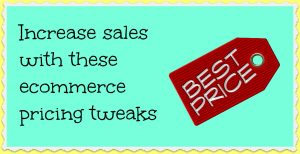In the survey we sent out, many of you said you’d like to a) increase your LHS sales, and b) learn how to sell more physical products.
In the spirit of “low hanging”, I thought I’d share a couple quick pricing tweaks that can help you with both of these things.
See – it’s remarkable how making a few changes to the way you word things can help you make more sales.
I’m going to give you a few different, easy, proven things you can do to make more sales when pricing your products.
I’d forgotten about some of these things and can’t wait to implement them!
And remember: even if you’re selling on Amazon, Etsy, etc and don’t have a ton of control over how these things are presented in a shopping cart, you can still edit your descriptions accordingly.
Here goes:
#1 End your prices in .97 to communicate a great deal

Many split tests say that of those odd numbers, “7” converts the best.
There are several theories for this. Some say it’s an unconscious thing related to the sound of the words -i.e. “seven” is apparently the most pleasing because the tone in the word descends, “eight” sounds flat, and “nine” is ascending. “7” is also associated with luck, which might have something to do with it.
Regardless of the reason, large stores who want to communicate “good value” regularly end their prices in 7.
Nordstrom, the high-end clothing store, normally ends their prices in “0” since they don’t compete on price. Nordstrom Rack, their discount brand, has all prices ending in “7”.
At Costco, a clearance price ends with a 7.
Most of Wal-Mart’s prices end in 7.
#2 Show the savings
If you’re offering a discount, show customers how much they’re saving so as to highlight the good deal they’re getting.
If you’re running a sale on an item, say “It’s 50% off. Save $7”, or “Was $14.95, now $7.95”.
This helps illustrate the value people are getting.
#3 Use numerical digits, not words
People have an easier and quicker time processing numbers than they do words.
Instead of saying everything is “half price,” say everything is “50% off”.
Since people “get” numbers faster, they can anchor in the deal better. When they’re sorting through lots of options, this gives you a competitive advantage.
#4 Establish a price anchor
Anchoring refers to the tendency to heavily rely on the first piece of information offered when making decisions.
If you establish the initial value of your goods to be, for example, $19.97 and then indicate an actual price of only $14.97, your customers will feel they’re getting a bargain.
If you’re advertising a huge price difference, like $14.97 down from $99.97, explain why your prices are cheaper so customers don’t feel like they’re being deceived.
#5 Reframe expenses with small words
Little words can make a big impact.
Saying something like “this only costs $9.95″ versus “this costs $9.95” has proven to make a difference in sales.
Another example of this is saying that something has a small $5 fee instead of a $5 fee.
Seemingly insignificant copy add-ons like that can have a surprisingly persuasive effect.
#6 Keep prices simple
Of these three options:
- $2,399.00,
- $2,399,
- $2399
…which do you think appeals the most to customers?
The answer is price #3: $2399.
That’s because it’s the simplest. There are no extra zeros and no commas, both of which make the first two prices seem more expensive. It also has the least amount of syllables, which subconsciously makes it feel smaller.
#7 Use words that are related to a small magnitude
In a study by the Journal of Consumer Psychology, participants preferred pricing on inline skates that had descriptions using words with “small” language, like “low friction” versus “high performance”.
If you want to compete on price, use words that reference a smaller magnitude (“small”, “tiny”, “low) versus words like “large”, “huge”, “massive”.
An example mug description tying this all in:
I know not all of you are selling mugs but since many of you are, here’s an example description that ties everything but #6 (reserved for higher priced items) in:
This easy-to-wash, dishwasher and microwave-safe mug is normally $24.97 — today there’s a 25% discount, making it only $19.97!
Your gift recipient will love this low maintenance mug that is sure to bring a smile to their face.
I hope this helps!












